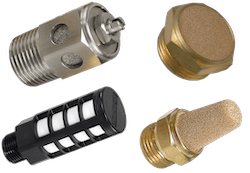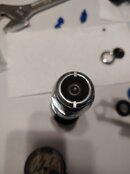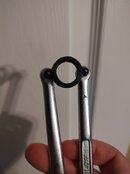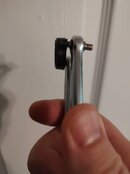I fully admit that this is a somewhat gut-level concept, but here goes ...
In this application, unlike other muffling applications that seem to have inspired these designs, we are dealing with a steady-state rather than impulse flow. In a firearm application, a significant portion of the overall efficacy is to spread inbound pressure wave out over time buy trapping the gas into expansion chambers, dropping the pressure and allowing it to release out of the bore at a lower velocity over time. Diameter is also a significant practical consideration.
For muffling the (essentially) steady-state flow from a tank valve it really comes down to how that pressure is dropped and where it is directed. I think that a disk of open-ended, spiraling radial expansion chambers might be the ticket. The idea being to allow the gas to expand in constant, controlled fashion to reduce velocity and be diffused radially. Maybe something in the 4-5" diameter category.
That expansion disk design can then be stacked several levels out from the valve. Balancing the distribution through the stack can probably be done by slightly reducing the thickness of the disks as they get further away from the valve, narrowing the central opening (start off with disk spirals that go all the way to the center and then cut the central channel of the stack with a cone) , or if you want to get really fancy, use some sort of variable-geometry central helix to turn the flow from linear to radial distribution.
In this application, unlike other muffling applications that seem to have inspired these designs, we are dealing with a steady-state rather than impulse flow. In a firearm application, a significant portion of the overall efficacy is to spread inbound pressure wave out over time buy trapping the gas into expansion chambers, dropping the pressure and allowing it to release out of the bore at a lower velocity over time. Diameter is also a significant practical consideration.
For muffling the (essentially) steady-state flow from a tank valve it really comes down to how that pressure is dropped and where it is directed. I think that a disk of open-ended, spiraling radial expansion chambers might be the ticket. The idea being to allow the gas to expand in constant, controlled fashion to reduce velocity and be diffused radially. Maybe something in the 4-5" diameter category.
That expansion disk design can then be stacked several levels out from the valve. Balancing the distribution through the stack can probably be done by slightly reducing the thickness of the disks as they get further away from the valve, narrowing the central opening (start off with disk spirals that go all the way to the center and then cut the central channel of the stack with a cone) , or if you want to get really fancy, use some sort of variable-geometry central helix to turn the flow from linear to radial distribution.








